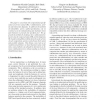Free Online Productivity Tools
i2Speak
i2Symbol
i2OCR
iTex2Img
iWeb2Print
iWeb2Shot
i2Type
iPdf2Split
iPdf2Merge
i2Bopomofo
i2Arabic
i2Style
i2Image
i2PDF
iLatex2Rtf
Sci2ools
APSEC
2007
IEEE
2007
IEEE
Realizability of Collaboration-based Service Specifications
This paper is concerned with compositional specification of services using UML 2 collaborations, activity and interaction diagrams. It addresses the problem of realizability: given a global specification, can we construct a set of communicating state machines whose joint behavior is precisely the specified one? We approach the problem by looking at how collaboration behaviors may be composed using UML activity diagrams. We classify realizability problems from the point of view of each composition operator, and discuss their nature and possible solutions. This brings a new look at already known problems: we show that given some conditions, some problems can already be detected at an abstract collaboration level, without needing to look into detailed interactions.
APSEC 2007 | Compositional Specification | Realizability Problems | Software Engineering | UML Activity Diagrams |
| Added | 12 Aug 2010 |
| Updated | 12 Aug 2010 |
| Type | Conference |
| Year | 2007 |
| Where | APSEC |
| Authors | Humberto Nicolás Castejón, Rolv Bræk, Gregor von Bochmann |
Comments (0)

